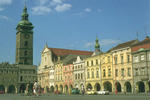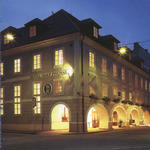|
 Guide Guide |
   Ceske Budejovice district Ceske Budejovice district
|
|
 The confluence of the big South Bohemian Vltava and Malse rivers was chosen by the Czech king Premysl Otakar II. in 1265 with a view to establishing the town of Ceske Budejovice and thus to strengthen his powerful position in South Bohemia. The regular ground plan of the newly established royal town, whose center is formed by an extensive quadrate square, is among the top works of medieval urbanism.
The confluence of the big South Bohemian Vltava and Malse rivers was chosen by the Czech king Premysl Otakar II. in 1265 with a view to establishing the town of Ceske Budejovice and thus to strengthen his powerful position in South Bohemia. The regular ground plan of the newly established royal town, whose center is formed by an extensive quadrate square, is among the top works of medieval urbanism.
The town grew economically due to the king's favor and a favorable position on distance commercial routes. Bohemian kings paid for the fidelity to the Royal crown to the citizens of Ceske Budejovice by awarding numerous privileges ensuring economic prosperity. As early as the turn of the 13th and the 14th centuries two magnificent cathedrals were completed and the town was surrounded by solid walls.
In the course of the turbulent 15th century the catholically oriented town of Ceske Budejovice represented a firm support against the Hussite movement. Zizka himself estimated well the solid character of the fortifications and did not even try to capture the town.
With its 4,000 inhabitants the medieval town of Ceske Budejovice was among the largest and most important towns of the Bohemian Kingdom. Nevertheless, it remained a town closed in the ring of the walls with several scattered agricultural estates and gardens in the suburbs.
The 16th century brought an unprecedented growth of the town and considerable profits flowing to the municipality particularly from silver mining in the surrounding mines as well as from beer brewing, pond economy and trade with salt. The accumulated means were  used by the community, among others, for an ostentatious presentation: a new town hall was built, the walls were rebuilt and the town council decided to erect a high tower, which is currently called "Black Tower". Ceske Budejovice thus took on a charming Renaissance face. In 1569 a mint was established here processing silver mined in the fields around the present Rudolfov. used by the community, among others, for an ostentatious presentation: a new town hall was built, the walls were rebuilt and the town council decided to erect a high tower, which is currently called "Black Tower". Ceske Budejovice thus took on a charming Renaissance face. In 1569 a mint was established here processing silver mined in the fields around the present Rudolfov.
During the course of the Estate Uprising and the subsequent Thirty Years' War Ceske Budejovice remained once more again at the Emperor's part and resisted attacks of the Estate Army. The modern fortification made the town a strategically important fortress where during the war in the 1630's provincial officers moved several times; the local church was temporarily hiding the Bohemian crown jewels.
Where as the war itself did not cause much damage, more than a half of the houses were destroyed in the fire of July 1641. The town renovation extended over several decades. Baroque era again profoundly changed the form of public buildings and private houses in the town, enriched Ceske Budejovice with several ecclesiastical sights and inter alia also with one of the town symbols - Samson's fountain.
Maria Theresa's reforms in the second half of the 18th century made Ceske Budejovice the seat of a newly created region. Also the Piarist Order, settling here in 1762 and establishing a Latin grammar school, contributed, to a great extent, to the cultural importance of the town. The town theater was established in the same period as well. In 1785, under the Emperor Joseph II., the bishopric of Ceske Budejovice was founded and not even two decades later the seminary and the philosophical institute started their activities.
Above the square rises the dominant architectural feature of Ceske Budejovice, the former bell tower and city watch-tower - the Black. It offers a beautiful view of the city and the countryside. Nearby stands the originally Gothic Church of St. Nicholas, dating from 1265.
Construction of the horse-drawn railway (1824-32) significantly helped the city's development, as it was the first large railway on the European continent. Since 1991, Ceske Budejovice has been the seat of a university, and it continues to be famous for its production of the famous beer, Budvar.
Tourists who come to the city may also visit expositions of the Southern Bohemian museum, galleries, or Ales's South Bohemian Gallery.   
|
|
|
Photo gallery
|
|

 |
 |
 |
 |
|
|
| |
 |
|
|
|
 |
|
 |
|
 |
|
 |
|
|
|
 |
|
 |
|
 |
|
 |
|
 |
|
 |
|
 |
|
|
|
 |
Ceske Budejovice district
|
|
|
|
 |
|
 |
|
 |
|
 |
|
 |
|
 |
|
|
 |
|
 |
|
 |
|
 |
|
 |
|
 |
|
 |
|
 |
|
|
 |
|
|
 |
|
 |
|

|
|
|
|
 Guide
Guide 





